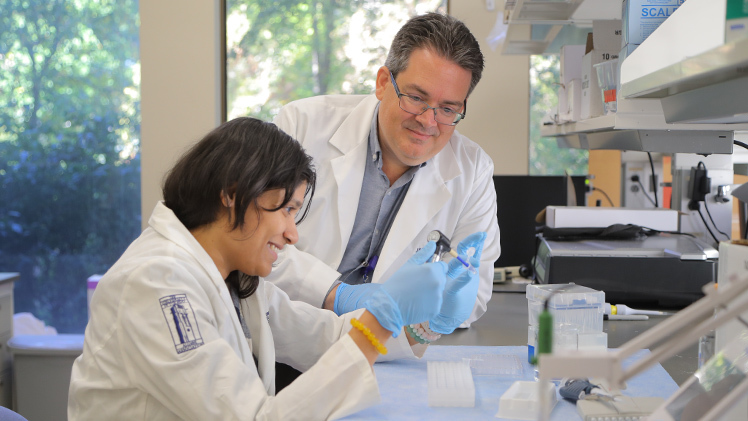Scientists studying neurodevelopmental disorders have identified hundreds of genetic variations that appear to be linked to autism, which is characterized by differences in how people communicate, learn and interact with others.
However, not everyone who has one or more of those genetic variations will ultimately be diagnosed with autism spectrum disorder.

Dr. James Burkett, an assistant professor of neuroscience, and N.J. Saferin, a Ph.D. Student in neuroscience. Burkett is leading a federally funded study that will examine how pesticides may combine with genetics to increase the risk of autism.
And even in those who do develop autism, it’s difficult to establish a genetic cause.
“In very few cases can we draw a direct line from a specific genetic abnormality to an autism diagnosis,” said Dr. James Burkett, an assistant professor of neuroscience in The University of Toledo College of Medicine and Life Sciences. “There are a lot of common genetic variants that raise the risk of autism, but those mutations don’t affect everyone in the same way. Autism is complex, and genes do not appear to be the only factor.”
So why do some individuals with genetic variants develop autism while others with the same genetic variants do not? Burkett believes one potential answer lies in the chemicals they’re exposed to early in their development, even while still in the womb.
A new study funded by the National Institutes of Health will explore that idea by looking at what happens when animals with a gene mutation known to be a significant risk factor for autism are exposed to pyrethroids — a common class of insecticide that has itself been implicated as an autism risk factor.
“These common gene variants may be creating a genetic predisposition for autism that is then accelerated by environmental insults, like exposure to a pesticide,” Burkett said. “This research should help us better understand how these interactions may be causing neurodevelopmental disorders.”
Burkett has previously published work in the peer-reviewed journal PNAS Nexus that looked at the offspring of female mice who were exposed to small doses of the pyrethroid insecticide deltamethrin before, during and immediately after pregnancy.
Researchers found those offspring exhibited increased hyperactivity and repetitive behaviors, fewer vocalizations and were more likely to fail basic learning tests compared to controls, even at levels recognized as safe by federal regulators. While Burkett makes clear he and his collaborators were not diagnosing those mice with autism, the behaviors they saw mirror the kinds of behaviors seen in children with autism.
His new research, supported by a $421,047 grant from National Institute of Environmental Health Sciences, builds on that work with a similar study of prairie voles — small rodents native to the Midwest whose monogamous relationships and empathetic practices make them unusual among mammals.
“The model is really important here. Not only can we study an animal that has the same gene as humans, but we’re also studying an animal with complex social interactions,” he said. “This is also an animal that naturally lives in our environment. They’re being exposed to the same things we’re exposed to. We’re interested in how it changes their behavior as well as ours.”
In the earlier study of mice, the animals had no specific genetic factors linked to autism. In the new study, researchers will pair a father with a defective gene known as SHANK3 with a mother that has a normal SHANK3 gene. Mutations in the SHANK3 gene in humans have been associated with autism spectrum disorder.
The resulting offspring will have a 50-50 chance of inheriting the mutated gene, providing control animals alongside those with a defective gene.
Pregnant voles will be exposed to low doses of the pyrethroid pesticide deltamethrin during pregnancy and lactation. The offspring — both those with normal and defective SHANK3 genes — will then be assessed for autism-related social, communication, cognition and repetitive behaviors. Researchers also will assess biological changes in the brain.
Pyrethroid pesticides including deltamethrin are some of the most widely used insecticides in the country, appearing in both consumer products and industrial preparations, including those used for mosquito fogging.
They’re so prevalent, Burkett said, that prior research has found traces of the chemical in 70-80% of blood samples from the general public.
“In our previous study, we showed that exposure to this pesticide in mice causes a change in behavior that looks very much like autism,” he said. “Now we’re asking why is it that only some people are developing autism when so many of us are being exposed. We suspect it may have to do with genetics.”
If that link is established, it could partially explain the continued increase in autism diagnoses.
The U.S. Centers for Disease Control and Prevention says that one in 36 children were identified with autism spectrum disorder in 2020, up from one in 68 a decade earlier.
Many autism researchers, including Burkett, believe part of the rise in prevalence is because of the increase in autism awareness and an increased willingness from physicians to make the diagnosis; however, he suspects there’s also a true increase in parentage of children affected by autism spectrum disorder.
“I’m very interested in trying to discover what might explain the dramatic increase in the incidence in neurodevelopmental disorders over the past 20 years, and increased environmental toxins seem like a strong possibility,” Burkett said. “You can’t change your genes, but we can modify our exposure to toxins. The primary significance of this work is in the potential to discover manmade, preventable causes of autism and neurodevelopmental disorders.”